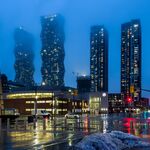The Humber bridge is a tourist destination in itself, it's always busy. Even on busy weekends I've never had an issue biking slowly across it though. Obviously you can't book it across, but that should be expected.
If I didn't make it clear, I meant approaching it, specifically climbing the hill up from the east. I'm more than willing to share on the "shared path", that's just plain courtesy, but when pedestrians block cycle traffic climbing the hill by being four across, are tinged with the bell, then asked if they could allow me and others to pass, and then got snarky...who is at fault? I could have been a pedestrian and walk far faster than what they were doing, in fact I do walk fast most times.
Would you drive that way? Hardly....
What is wrong with "slow traffic keep to the right"? There is a pedestrian only track immediately adjacent. So why purposely block cyclists? I was slowed to the point of not being able to maintain balance. So were others behind me. That's impeding traffic, pedestrian and cyclist alike.
On the bridge itself is complete milieu most times, and like the Waterfront, one is best to dismount and walk through it.
82
Toronto Multi-Use Trail Design Guidelines
Toronto Multi-Use Trail Design Guidelines
83
DESIGNATION SYMBOLS
Designation symbols typically communicate shared-use,
or single use. At minimum, designation symbols should
be placed at the beginning of a trail, the entrance to any
stage of a crossing, and shortly after a crossing. They can
also be placed at intervals along the length of a trail to
remind trail users to keep to the right. Directional arrows
are used in conjunction with designation symbols in most
situations except for at crossings
[...]
7.6. Passing Areas
Passing areas are simply widened parts of a trail,
continuous with the trail surface. They are located
strategically at areas where slower users can move
aside (to the right) and allow faster users to pass on
their left. The minimum widening should be 0.3 metres
on each side of the trail, and should be increased to
accommodate higher use or higher levels of potential or
reported conflicts. Passing areas should be at least five
to ten metres long, and should be signed with an info
sign placed adjacent to the start of the widened part of
the trail.
Passing areas should be implemented in the following
situations:
•
where trails intersect or merge, leading to a localized
area of high use;
•
on slopes;
•
in areas of restricted visibility such as densely
vegetated areas or sharp curves in the trail;
•
intermittently through areas where trail widths are
less than desired; and/or
•
adjacent to, or occasionally in place of fully-developed
resting and viewing areas
[...]
https://www1.toronto.ca/City Of Toronto/Transportation Services/Cycling/Files/pdf/TORONTO MULTI-USE TRAIL DESIGN GUIDELINES-December 2014_Fina_4.pdf
 Ask Toronto Cyclists: Where do I walk?
http://www.ibiketo.ca/blog/2007/11/05/ask-toronto-cyclists-where-do-i-walk
Ask Toronto Cyclists: Where do I walk?
http://www.ibiketo.ca/blog/2007/11/05/ask-toronto-cyclists-where-do-i-walk
More of this is needed:













